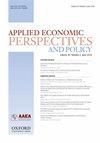美国农业的劳务承包商:最近的趋势和H-2A计划的使用
IF 3.4
2区 经济学
Q2 AGRICULTURAL ECONOMICS & POLICY
引用次数: 0
摘要
本文分析了20年来美国农业劳务承包商(FLCs)的就业趋势和特征数据。低收入家庭主要集中在特定的工业和地区,特别是水果和蔬菜部门,以及加州和东南部。我们表明,在过去的二十年中,由FLCs填补的作物劳动力职位的比例稳步上升,特别是在加利福尼亚州。此外,flc已成为H-2A工人的重要雇主,目前占H-2A工作岗位的40%以上。最后,我们发现在一些常用的数据集中排除H-2A可以显著影响FLC就业的估计。本文章由计算机程序翻译,如有差异,请以英文原文为准。
Labor contractors in U.S. agriculture: Recent trends and H-2A program usage
This paper analyzes 20 years of data on employment trends and characteristics of U.S. farm labor contractors (FLCs). FLCs are primarily concentrated in specific industries and regions, particularly in the fruit and vegetable sectors, and in California and the Southeast. We show that the proportion of crop labor positions filled by FLCs has steadily increased over the past two decades, especially in California. Additionally, FLCs have become significant employers of H-2A workers, now accounting for over 40% of H-2A jobs. Lastly, we show that H-2A exclusion in some commonly used datasets can significantly affect estimates of FLC employment.
求助全文
通过发布文献求助,成功后即可免费获取论文全文。
去求助
来源期刊

Applied Economic Perspectives and Policy
AGRICULTURAL ECONOMICS & POLICY-
CiteScore
10.70
自引率
6.90%
发文量
117
审稿时长
>12 weeks
期刊介绍:
Applied Economic Perspectives and Policy provides a forum to address contemporary and emerging policy issues within an economic framework that informs the decision-making and policy-making community.
AEPP welcomes submissions related to the economics of public policy themes associated with agriculture; animal, plant, and human health; energy; environment; food and consumer behavior; international development; natural hazards; natural resources; population and migration; and regional and rural development.
 求助内容:
求助内容: 应助结果提醒方式:
应助结果提醒方式:


